Does Yoga Help Reduce Anxiety in Dogs?
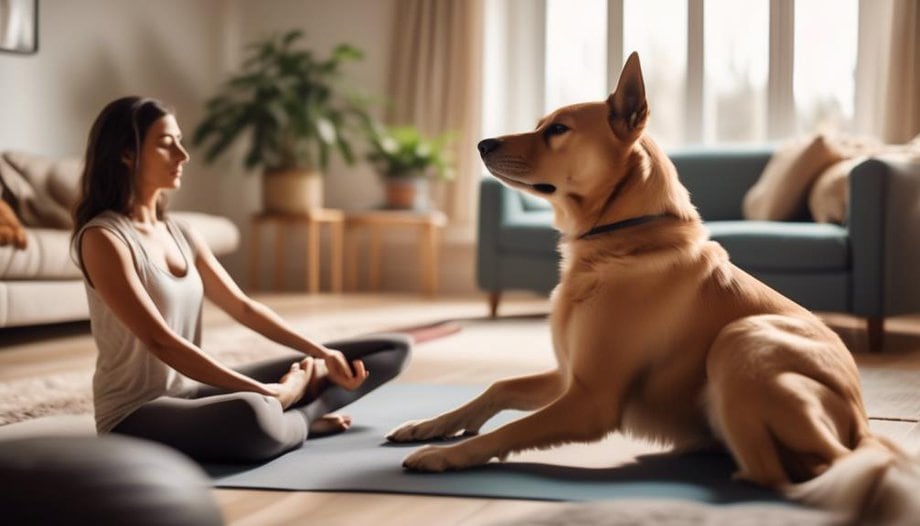
Yoga may help reduce anxiety in dogs. It does this by promoting relaxation and reducing stress levels. This is achieved through its gentle movements and focus on breath.
Key Takeaways
- Yoga has been shown to reduce anxiety in dogs.
- Mindfulness, a key component of yoga, can help dogs become more aware of their own emotions and better manage stress and anxiety.
- Canine yoga, or doga, can promote relaxation and reduce stress in dogs.
- Participating in yoga sessions with their owners can strengthen the bond between dogs and their owners.
The Science Behind Yoga for Dogs
The scientific evidence supporting the effectiveness of yoga in reducing anxiety in dogs is steadily growing. While research on yoga for dogs is still in its early stages, preliminary studies have shown promising results.
One study conducted at the University of California, Davis, found that dogs who regularly participated in yoga sessions experienced a significant decrease in anxiety levels compared to a control group. Another study conducted at the University of Veterinary Medicine in Vienna found that dogs who practiced yoga showed improved adaptive behavior and reduced signs of stress.
The benefits of mindfulness, a key component of yoga, for dogs are also being explored. Mindfulness involves being fully present in the moment and paying attention to one's thoughts, feelings, and surroundings without judgment. This practice can help dogs become more aware of their own emotions and better manage stress and anxiety. Similar to humans, dogs can benefit from the calming effects of deep breathing exercises and gentle stretching that are part of yoga.
Furthermore, yoga for cats is also gaining attention as a potential tool to reduce anxiety and promote relaxation in feline companions. Preliminary studies have shown that cats who engage in yoga activities exhibit reduced signs of stress and improved overall well-being.
However, it's important to note that more research is needed to fully understand the mechanisms and effects of yoga on dogs and cats. As the scientific community continues to explore this field, it's hoped that more evidence will emerge to support the use of yoga as a therapeutic tool for reducing anxiety in our beloved animal companions.
Understanding Canine Anxiety
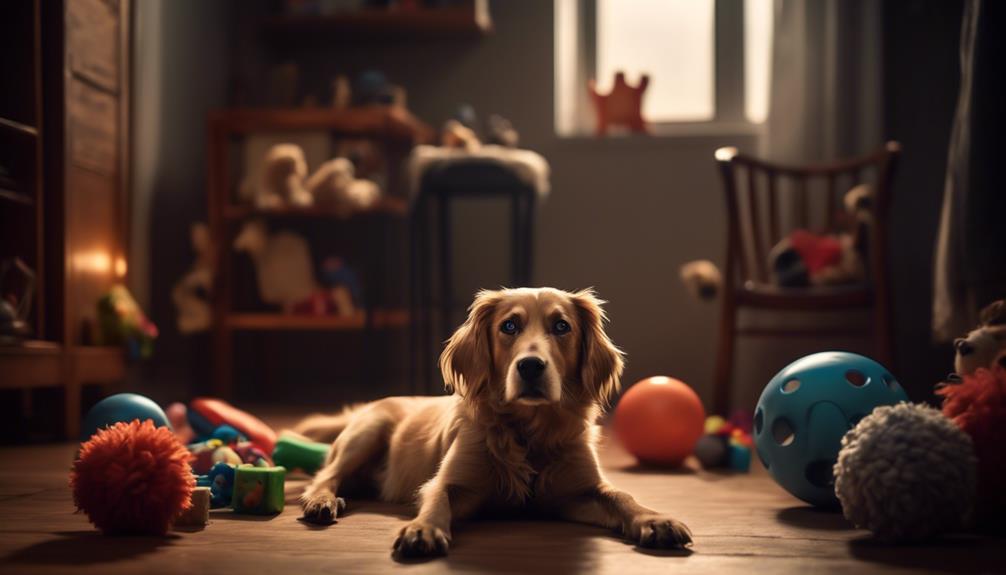
Canine anxiety is a common behavioral issue observed in dogs that can be caused by a variety of factors. Understanding the symptoms and causes of anxiety in dogs is crucial for providing them with the appropriate support and care. Here are three important aspects to consider:
- Behavioral Symptoms: Dogs experiencing anxiety may exhibit various behavioral signs. These can include excessive barking, panting, pacing, trembling, restlessness, destructive behavior, aggression, decreased appetite, and even self-harm. It's essential to recognize these symptoms to intervene effectively.
- Situational Triggers: Anxiety in dogs can be triggered by specific situations or events. Common triggers include separation from their owners, loud noises (such as thunderstorms or fireworks), unfamiliar environments, car rides, or being around other animals. Identifying the triggers can help in developing strategies to manage and alleviate their anxiety.
- Underlying Causes: The causes of anxiety in dogs can be multifactorial. They may include genetics, previous traumatic experiences, lack of socialization, changes in routine or environment, and medical conditions. Identifying the underlying causes can assist in addressing the root issues and implementing appropriate interventions.
Benefits of Yoga for Dogs
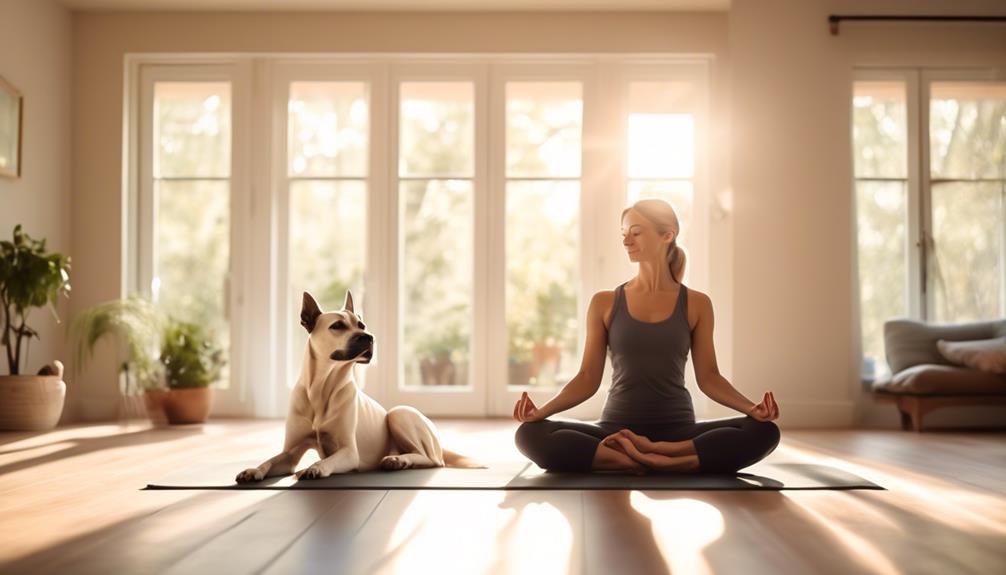
Understanding the potential benefits that yoga can provide for dogs experiencing anxiety is crucial for developing effective interventions. Canine yoga, also known as doga, is a practice that involves incorporating dogs into traditional yoga poses and exercises. This form of yoga has gained popularity among pet owners as a means to promote relaxation and reduce stress in their furry companions.
Research on the benefits of yoga for dogs is still limited, but anecdotal evidence suggests that it can have positive effects on their mental and physical well-being. Some potential benefits of canine yoga include:
- Stress reduction: Like humans, dogs can experience stress and anxiety. Canine yoga provides a calming environment and teaches dogs to relax and focus, helping to alleviate their anxiety.
- Increased flexibility and strength: Yoga poses encourage dogs to stretch and move their bodies in new ways, which can improve their flexibility and strengthen their muscles.
- Bonding with owners: Participating in yoga sessions with their owners allows dogs to strengthen their bond and develop a sense of trust and connection.
- Mental stimulation: Canine yoga engages dogs' minds and encourages them to focus and concentrate, which can provide mental stimulation and prevent boredom.
- Improved overall well-being: Regular practice of canine yoga may contribute to dogs' overall well-being by promoting relaxation, reducing stress, and increasing physical and mental fitness.
While more research is needed to fully understand the benefits of yoga for dogs, incorporating this practice into the lives of canines may offer a holistic approach to reducing anxiety and improving their overall quality of life.
How to Introduce Yoga to Your Dog
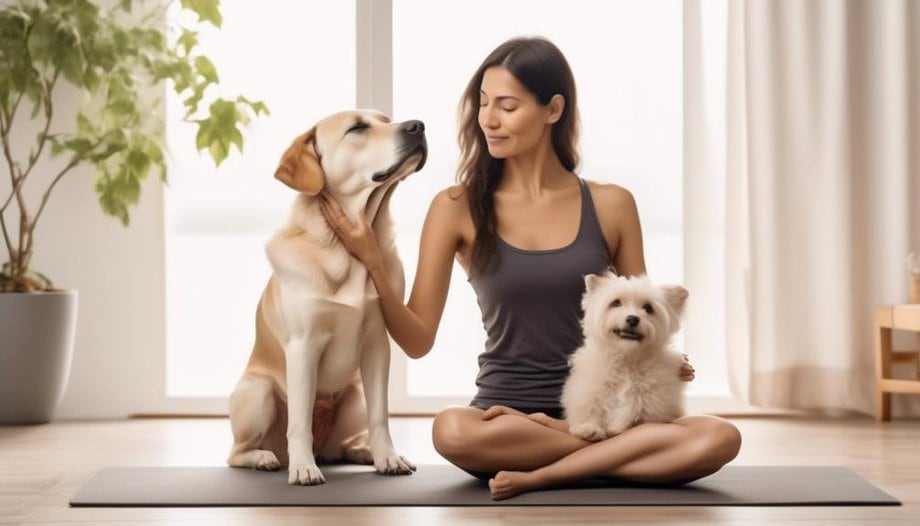
Introducing your dog to yoga can be a beneficial and enjoyable experience for both you and your furry companion. However, it's important to approach it with caution and understanding. Here are three key points to keep in mind when introducing yoga to your dog:
- Start Slowly: Just like humans, dogs need time to adapt to new activities. Begin by incorporating short yoga sessions into your daily routine. Gradually increase the duration as your dog becomes more comfortable and familiar with the practice.
- Use Positive Reinforcement: Dogs respond well to positive reinforcement. Reward your dog with treats, praise, and affection during and after each yoga session. This will create a positive association with the practice and motivate your dog to participate willingly.
- Choose the Right Environment: Dogs are sensitive to their surroundings. Find a quiet and calm space where you and your dog can practice yoga without distractions. Make sure the area is clean and free from any potential hazards. This will help create a relaxing environment that promotes focus and reduces anxiety.
Common mistakes to avoid in dog yoga practice include forcing your dog into poses, overexerting them, or neglecting their individual needs and limitations. Always respect your dog's comfort level and listen to their cues. With patience, consistency, and proper guidance, you can introduce yoga to your dog in a safe and beneficial manner.
Best Yoga Poses for Anxious Dogs
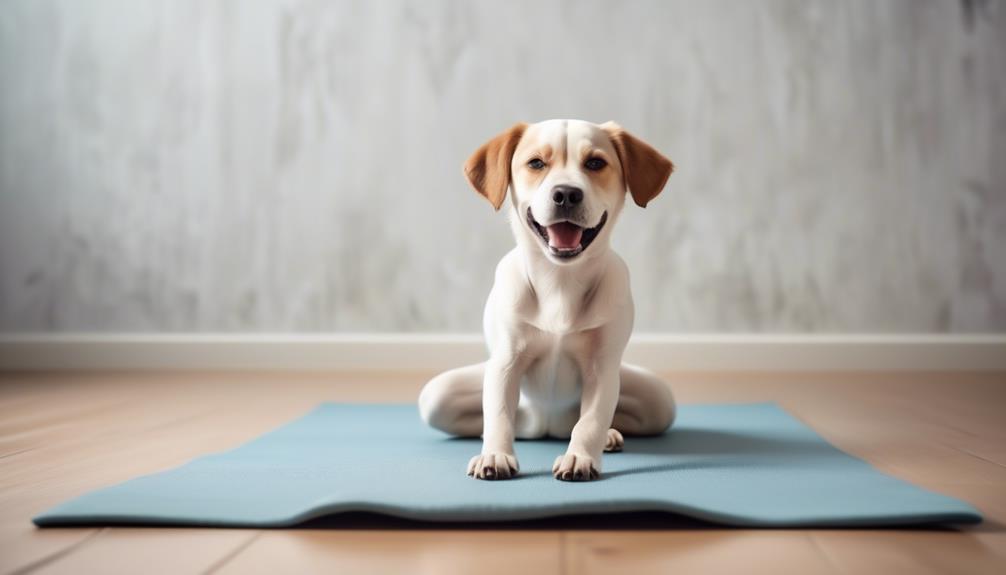
The best yoga poses for anxious dogs can provide numerous benefits, helping to alleviate their anxiety and promote a sense of calm. These poses work by activating the parasympathetic nervous system, which is responsible for rest and relaxation.
Through gentle stretching, deep breathing, and mindfulness, dogs can experience a reduction in anxiety and an overall improvement in their well-being.
Benefits of Dog Yoga
Incorporating specific yoga poses into a dog's routine can potentially alleviate anxiety and promote overall well-being. Dog yoga classes are becoming increasingly popular as pet owners recognize the calming benefits of yoga for dogs.
Here are three of the best yoga poses for anxious dogs:
- Downward-Facing Dog: This pose helps stretch and lengthen the spine, promoting relaxation and reducing stress. It also strengthens the core muscles, improving stability and balance.
- Child's Pose: This pose encourages deep relaxation and helps dogs release tension in their neck and shoulders. It can also provide a sense of security and comfort, making it especially beneficial for anxious dogs.
- Bridge Pose: This pose opens up the chest and stretches the abdomen, promoting deep breathing and relaxation. It also strengthens the hindquarters and improves flexibility.
Incorporating these yoga poses into a dog's routine can help reduce anxiety and promote a sense of calm and well-being.
How Yoga Calms Dogs
Yoga poses specifically tailored for anxious dogs have been found to effectively induce a state of calm and relaxation. These poses, also known as asanas, help dogs release tension and anxiety, promoting a sense of peace and well-being. By incorporating slow, controlled movements and deep breathing exercises, yoga can help dogs regulate their nervous system and reduce stress levels.
Here are some of the best yoga poses for calming dogs:
| Pose | Benefits | Instructions |
|---|---|---|
| Downward-Facing Dog | Relieves anxiety, stretches muscles, calms the mind | Start in a tabletop position, then lift hips up and back, forming an inverted "V" shape |
| Child's Pose | Promotes relaxation, relieves tension in the back and shoulders | Start on all fours, then sit back on heels and reach arms forward, resting forehead on the ground |
| Legs-Up-The-Wall Pose | Soothes the nervous system, reduces anxiety, improves circulation | Lie on the floor with legs extended up against a wall, forming a 90-degree angle with the body |
Tips for Practicing Dog Yoga
To ensure a successful practice of dog yoga and effectively calm anxious dogs, it's important to follow these helpful tips:
- Start with gentle poses: Begin the practice with simple poses that allow the dog to get comfortable and familiarize themselves with the practice. Gentle stretches and poses like the Downward-Facing Dog and Child's Pose can help reduce anxiety and promote relaxation.
- Use positive reinforcement: Dogs respond well to positive reinforcement, so during the practice, make sure to reward them with treats or praise when they exhibit calm behavior. This will create a positive association with the yoga practice and encourage the dog to continue participating.
- Create a peaceful environment: Find a quiet and peaceful space for the practice where the dog feels safe and secure. Eliminate any distractions or loud noises that may trigger anxiety. Using calming music or essential oils can also enhance the relaxing atmosphere.
Incorporating Yoga Into Your Dog's Routine
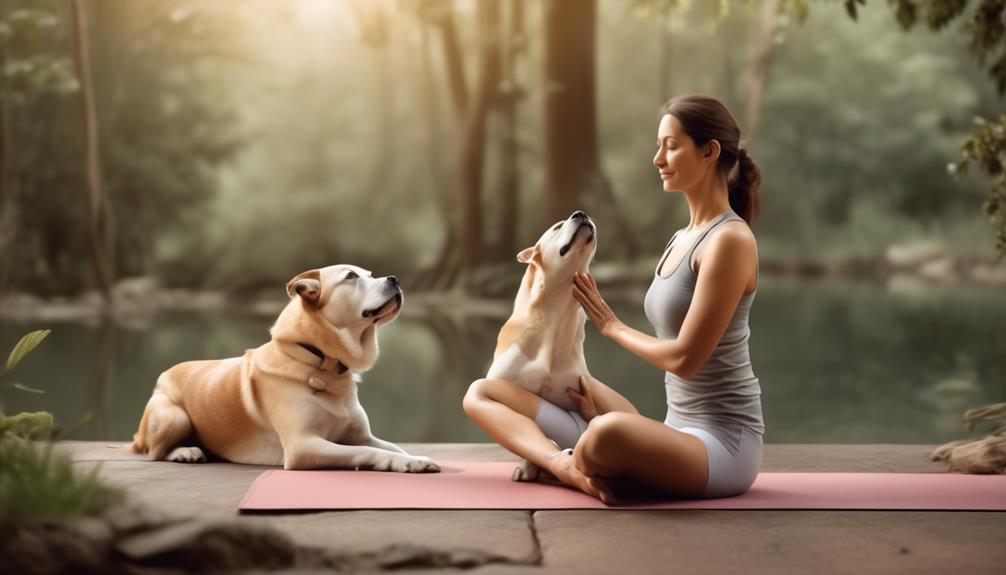
Incorporating yoga into a dog's routine can provide numerous benefits for their overall well-being. Yoga poses specifically designed for dogs can help improve their flexibility, strength, and balance. Additionally, engaging in yoga with your dog can strengthen the bond between you and provide a calming and relaxing experience for both of you.
To get started, it's important to follow some basic tips and guidelines to ensure a safe and enjoyable yoga practice for your furry friend.
Yoga Poses for Dogs
Canine companions can benefit from the integration of yoga poses into their daily routines, providing a holistic approach to reducing anxiety and promoting overall well-being. Incorporating yoga into a dog's routine can be done at home or through specialized dog yoga classes. To ensure a successful yoga practice for dogs, certain equipment can be used to enhance their experience.
Here are three essential yoga poses for dogs:
- Downward Dog: This pose stretches the entire body, strengthens the core, and promotes relaxation.
- Puppy Pose: Similar to Child's Pose in human yoga, this pose allows dogs to stretch their spine and release tension in their muscles.
- Upward-Facing Dog: This pose opens the chest and shoulders, improves flexibility, and encourages deep breathing.
Benefits of Dog Yoga
Dog yoga, also known as doga, offers numerous benefits for our furry friends when incorporated into their daily routines. Not only does it provide physical exercise, but it also promotes mental relaxation and strengthens the bond between dogs and their owners. By practicing canine relaxation techniques, such as gentle stretching and breathing exercises, dogs can experience a sense of calm and reduce anxiety. Additionally, engaging in dog yoga with your pet can create a deeper connection and trust between you and your dog.
Here is a table illustrating some of the key benefits of incorporating dog yoga into your dog's routine:
| Benefits of Dog Yoga |
|---|
| Physical exercise |
| Mental relaxation |
| Reduced anxiety |
| Improved flexibility |
| Strengthened bond with owner |
Incorporating dog yoga into your dog's routine can provide a holistic approach to their overall well-being, promoting both physical and mental health while fostering a deeper connection with your beloved pet.
Tips for Starting Yoga With Your Dog
To successfully introduce yoga into your dog's routine, it's important to start with simple and gentle poses that allow for gradual acclimation and relaxation. Here are three tips for starting yoga with your dog:
- Choose a quiet and comfortable area outdoors: Starting yoga outdoors can provide a refreshing and calming environment for both you and your dog. Find a peaceful spot in your backyard or a nearby park where you can practice without distractions.
- Begin with partner yoga poses: Partner yoga with your dog can enhance the bond between you and provide numerous benefits. Start with poses that involve gentle stretching and touch, such as seated forward bends or gentle twists. Remember to be mindful of your dog's comfort and never force them into a pose.
- Use positive reinforcement and rewards: Encourage your dog's participation in yoga by using positive reinforcement techniques. Reward them with treats, praise, or their favorite toy after each successful pose or relaxation session. This will help create a positive association with yoga and make it an enjoyable experience for your furry friend.
Additional Techniques to Reduce Dog Anxiety

Using positive reinforcement techniques and environmental enrichment can be effective in reducing anxiety in dogs. In addition to these methods, there are several alternative therapies and natural remedies that can help alleviate anxiety in our furry friends.
One popular alternative therapy is aromatherapy. Certain essential oils, such as lavender and chamomile, have calming properties and can be used to create a soothing environment for dogs. However, it's important to note that not all essential oils are safe for dogs, as some can be toxic. Therefore, it's crucial to consult with a veterinarian or a certified aromatherapist before using essential oils on your dog.
Another natural remedy that may help reduce anxiety in dogs is the use of herbal supplements. Herbs such as valerian root, chamomile, and passionflower have been found to have calming effects on dogs. However, it's essential to consult with a veterinarian before giving your dog any herbal supplements to ensure proper dosage and to rule out any potential interactions with other medications.
Additionally, music therapy has shown promise in reducing anxiety in dogs. Classical music or specially composed music designed to calm dogs can create a relaxing atmosphere and help alleviate stress.
While these alternative therapies and natural remedies can be beneficial in reducing dog anxiety, it's important to remember that every dog is different. It's crucial to consult with a veterinarian before trying any new treatments to ensure they're safe and appropriate for your furry friend.
Frequently Asked Questions
How Long Should a Yoga Session Be for Dogs?
A typical yoga session for dogs should last around 20-30 minutes. Regular yoga practice can provide numerous benefits for dogs, such as improved flexibility, strength, and reduced stress levels.
Can Any Dog Participate in Yoga, Regardless of Age or Breed?
Any dog, regardless of age or breed, can participate in yoga. Yoga can provide benefits for senior dogs by improving flexibility and joint health. It is important to modify yoga poses to accommodate different dog breeds for their safety and comfort.
Is It Safe to Practice Yoga With a Dog Who Has a History of Aggression or Fearfulness?
Yoga with aggressive dogs or fearful dogs requires caution. It is important to consult with a professional trainer or behaviorist before attempting yoga. They can provide guidance on how to safely engage with the dog and reduce anxiety.
Are There Any Risks or Potential Side Effects Associated With Yoga for Dogs?
There are potential risks and side effects associated with yoga for dogs. It is important to consider the individual dog's health and temperament before starting any yoga practice.
Can Yoga Be Used as a Standalone Treatment for Canine Anxiety, or Should It Be Used in Conjunction With Other Methods?
Yoga as a complementary therapy can be beneficial for dogs with anxiety. However, it is best used in conjunction with other methods to address the underlying causes of anxiety and provide comprehensive treatment.









